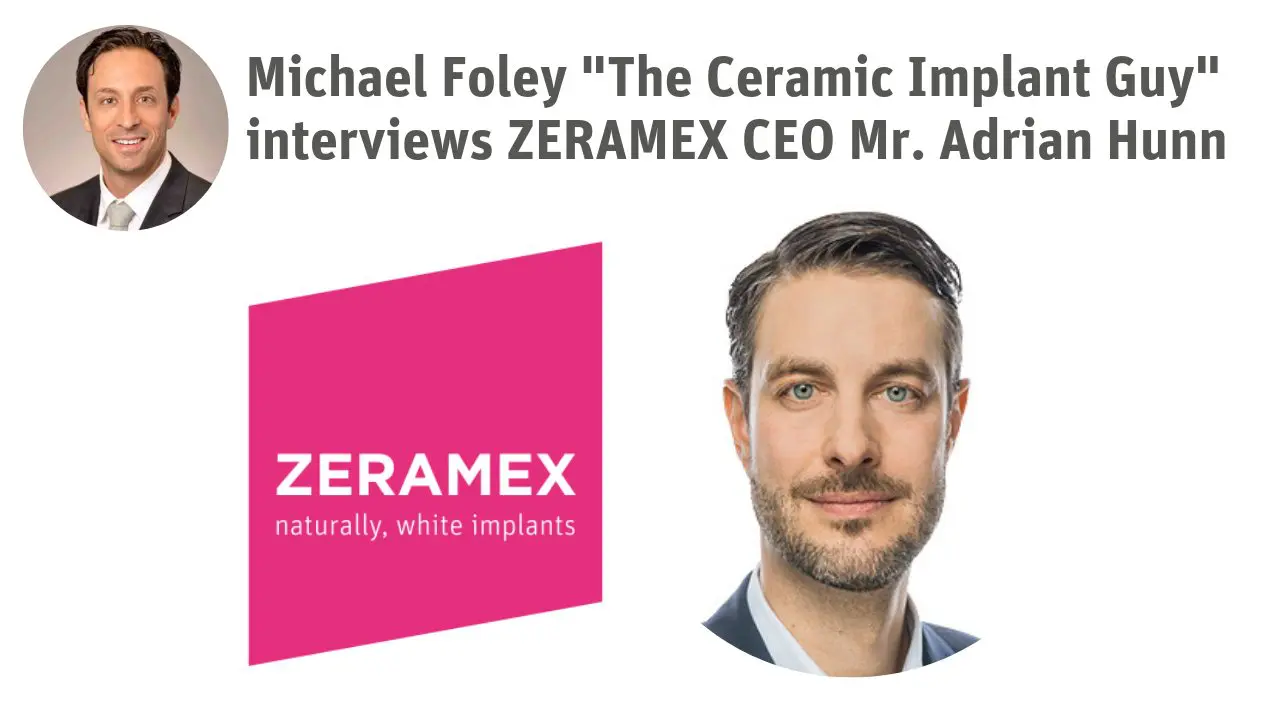All, Educational Videos
Michael Foley “The Ceramic Implant Guy” interviews ZERAMEX CEO Mr. Adrian Hunn
Watch this interview between Michael Foley, Founder of Emerginnova – ZERAMEX USA and Adrian Hunn, CEO of ZERAMEX Switzerland. In this video, they are talking about the new branding for ZERAMEX and some very exciting news!
Questions and answers during the interview:
Re-branding, new images and the new look!
Hunn: We are extremely excited to finally come out with that. We have a completely new logo and a new brand appearance. And as you can see, it’s ZERAMEX, naturally white implants. That’s what we do, that’s our vision. That’s what we stand for. Our vision is of course, that in the future, 100% of all the implants are actually white. That means ceramic and completely metal free.
About the new logo
Hunn: This is part of it, you can also see this graphic of an Xray in pink with the naturally white implant, how aesthetically it looks. This comes back a little bit to the briefing. The briefing was they wanted to do, to transmit, to transport in our communications the Aesthetics, also that it is all Natural. You know, it’s inert material, we also do that. And also quality, we produce quality products made in Switzerland. Swiss quality! Swiss made 100%. It’s hard to claim that in any other industry, but you know, for our implants we have our production set-up in Switzerland, our headquarters is there, it’s 100% Swiss made.
We have a couple of requirements for the new branding here. One of it – because research shows that women are buying double the amount of implants than men. At least in Europe, I know that more people leaving dentist school are women, that’s 60% vs 40%. Women are actually conquering this profession, so we want to be very attractive to women you know two-fold – as dentists as well as patients.
More and more dentists, actually they want to open up a white clinic – completely metal-free implants, ceramics, etc. And they usually play in aesthetics, quality aesthetics is very important for them. And the ultimate criteria – what would they hang on the wall. And I think a picture like that – white implant, the Xray in pink, which is actually our color since the beginning of the brand, they would hang that. And I got this confirmation from customers because this was not made in a little Swiss headquarters without talking to anyone, so we had custom surveys. We showed it to customers it was a bit of an international process.
New Branding, New Logo, and much more to come!
What’s going on in ZERAMEX in 2019
Hunn: It’s actually growing a lot. It’s an exciting year and I had the pleasure to travel with Michael to the US, Manhattan, visiting doctors also down in Florida, it’s actually the third or fourth time because I’m always hearing from these doctors, I’m seeing more and more patients coming in and asking for metal-free or ceramic implants. That’s exactly the same trend as we see in Europe, so I think we have the right product at the right time. And, you know it better than myself, but we have a couple of unique US pieces, our product, we are the only one with complete two-part ceramic implant which is screwed and reversible.
And then we are working on a couple of exciting product innovations which will come this year. Later on, we will have a smaller diameter for our ZERAMEX XT product. We are working on the prosthetic part – means Digital Workflow, some for locators, etc.
We are not standing still; we are moving quite fast.
In the US we are seeing a lot of growth, with not just the biologic community, we are seeing growth throughout dentistry. Is that what you see in Germany? Why do you think that is?
Hunn: We see the same trend in Germany as well. I think the main thing is that ceramic implants or metal-free implants now have arrived in the mainstream market and it’s not something you can stop. Either you go with the flow and you start offering it, or you will lose business as a dentist in the future. This is scary, especially if you’re in the industry for the next twenty years because we can meet whatever stock published. They say that ceramic implants will have a great market share in the future and it doesn’t matter whether ten, twenty or thirty percent, it’s way more than it is today. So that means, if two patients are asking per month for ceramic or metal-free implants, it will be fifteen in the next couple of years. Either you serve them or they get served elsewhere.
The History of ZERAMEX®
Hunn: I think first of all, we think it’s ceramic. The company was founded in 2005. By 2007 we had our first product in the market and we and it was always the vision that there are two-parts ceramic implant and also the vision to be at par with the handling of titanium implants. It took a long time to get there but at 2015 we were there. Our latest product which you can actually see it here. It’s called ZERAMEX XT: Two-parts, fully ceramic and see for this, we have carbon fiber screw made out of parallel lining carbon fiber which gives them stability. And we have about seven patents and about seven patents pending. So, we’re definitely the leader in the manufacturing of ceramic implant, because the material we use in these implants is called ATZ – it’s a Zirconia stabilized magnesium and aluminum oxide. It’s the sixth hardest material in the world. You can only manufacture and work on it with diamond tools. And so we developed a process which is kind of a secret in a chamber, how you make this tool sharper so we can have a unique implant design, abutment design and together with the screw, I think you will like it. It’s hard because if you look out there, no one offers a complete metal-free two-part ceramic implant.
ZERAMEX® as a manufacturing company
Hunn: When I was looking back, because I was not there in the beginning, it was Jüerg Bolleter, the founder and chairman of the company. I would say that the company has gone through three phases. First, we’ve got product evolvement. I think that took a little bit longer than expected because it’s a hard material and complicated to get it. Then we had the product, the second step was to learn how to manufacture this product in a very new and precise way. So you think of the quality but also control the manufacturing cost to a certain degree because that’s more expensive than manufacturing a titanium implant. And now with the third step, and I think it’s the most exciting, it’s rolling out international distribution. So far, focus was Europe, now we are growing very nicely in the US, as Michael, also thanks to you we are growing extremely nicely in the US. And now we are entering Asia, Australia, New Zealand. I think it would be hard to not combine ZERAMEX in the future.
Is Zirconia a metal?
Hunn: First of all, I’m not an engineer, but nevertheless, I will try to answer this question. Zirconium is a metal and Zirconia is actually the oxide of this metal. So, this is a process from Zirconium to Zirconia. While doing this process, the material loses all its properties that makes it metal. So, the oxide of that is never metal. The same actually with Aluminium and Aluminia. So, Zirconia is definitely not a metal. And you can ask every chemistry professor in the entire world that is well-educated and will give you more or less the same answer with a lot more details and a lot more profound knowledge than me. But Zirconia is NOT a metal.
Peri-implantitis: A growing issue throughout the country
Hunn: I think another huge topic is peri-implantitis. It’s one of the major conflicts. I’m not here claiming that there will be no peri-implantitis using Zirconia implants but we see currently that there is less and less.
Why?
Hunn: Honestly, I think there is no good answer to that so far. I think it is part of the material. It’s an inert material. So it’s very good for the body. If you ever saw a gingiva flowing around even a Zirconia crown, you know how the body reacts. We know also that the bone is growing really well. The body accepts Zirconia really well.
Foley: To me that’s the most exciting thing about our product. Peri-implantitis, we know is a growing issue throughout the country, throughout the world. And I think one of the main reasons why we don’t see as much peri-implantitis is that it is an inert product. It doesn’t have a magnetic traction – the electric charge. We see the ten percent of the bacteria in plaque in fusion of a titanium. We have ninety percent reduction with Zirconia. To me, that is the sleeping giant that’s going to awaken and create a huge dent for our solution.
Hunn: Definitely. I think that there are currently a lot of studies of what implants they are comparing, and if we have enough data, I’m pretty sure a lot of people don’t understand that this could be a solution. I think we just don’t have enough data so far, but what I see with our product, it’s going to be very promising.
Contact
Want to know more about Zeramex?
Email us at mfoley@zeramexusa.com with your contact details and we will get in touch with you!
ZERAMEX BROCHURE
Click here to download the Zeramex sales brochure



Comments are closed.